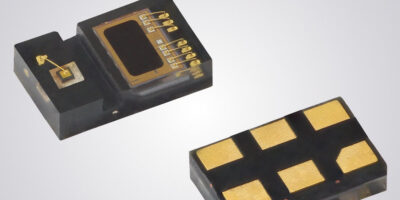Proximity sensor reduces power consumption in wearables
Power consumption is reduced to just 6.63 microA by the Optoelectronics Group of Vishay Intertechnology in its VCNL36825T integrated proximity sensor. The surface mount package measures 2.0 x 1.25 x 0.5mm. It has a vertical-cavity surface-emitting laser (VCSEL) and a 1.6mm light hole. The sensor is suitable for space-constrained battery-powered applications can be used in consumer and industrial applications, such as true wireless stereo (TWS) and virtual reality / augment reality (VR / AR) headsets. The sensor has a range of 200mm, which means it also provides collision detection in toys and consumer and industrial robots.
The VCNL36825T also has a photodiode, signal processing IC, and 12-bit ADC which is a 76 per cent smaller package than previous-generation devices, while its reduced light hole opening provides increased design flexibility, at a lower cost, says Vishay Semiconductors.
The VCNL36825T supports the I²C bus communication interface for easy access to the proximity signal, and its programmable interrupt function allows designers to specify high and low thresholds to reduce the continuous communication with the microcontroller. The proximity sensor uses intelligent cancellation to eliminate crosstalk, and a smart persistence scheme ensures accurate sensing and faster response time. The VCSEL wavelength peaks at 940nm and has no visible “red-tail,” adds Vishay.
Temperature compensation is -40 to +85 degrees C and Moisture Sensitivity Level (MSL) is 3, in accordance with J-STD-020, for a floor life of 168 hours. The sensor is RoHS-compliant and halogen-free.
Samples and production quantities are available now, with lead times of eight to 12 weeks for large orders.
Vishay claims to manufacture one of the world’s largest portfolios of discrete semiconductors and passive electronic components for designs in the automotive, industrial, computing, consumer, telecommunications, military, aerospace, and medical markets.




